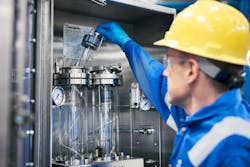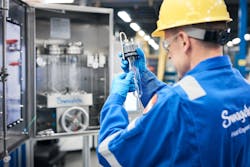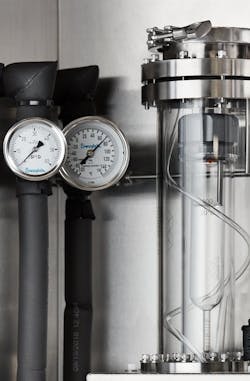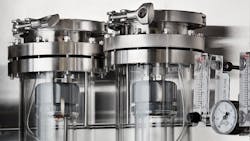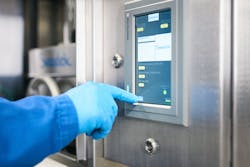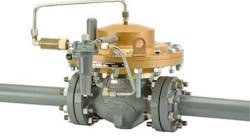Chemical plants and refineries that produce fertilizers, plastics, textiles, petroleum and more use many different chemicals. One of the most common is anhydrous ammonia since pure ammonia is not ideal for these applications. To prevent corrosion and contamination of end products, such facilities must add water to the ammonia in a range between 0.2% and 0.5%. Operators must then consistently test the anhydrous ammonia to ensure its water content remains within the specified range.
Testing ammonia is a challenging process that demands the use of extensive personal protective equipment (PPE). This includes wearing goggles, gloves, a respirator and a chemical suit because exposure to ammonia vapors could be fatal. Thus begins the hours-long testing procedure, which can result in inaccurate results if operators make even the slightest mistake.
Fortunately, new methods of ammonia testing can save time and money. Employing an updated sampling protocol can improve efficiency, accuracy and safety, while keeping the operation performing optimally.
Traditional ammonia testing
Typically, facility managers instruct their technicians to use the CGA G-2.2 method or a similar approach for ammonia sampling, which involves collecting a 100-ml sample of liquid ammonia and observing its evaporation. Then, technicians will measure the amount of water that remains to calculate the ammonia’s water content. If the water content falls outside of the desired range of 0.2% to 0.5%, immediate remediation is necessary.
The importance of accurately testing anhydrous ammonia cannot be overstated. Insufficient water content can cause stress cracking in storage tanks or other fluid system components, potentially destroying entire systems. Furthermore, stress corrosion cracking is difficult to detect as it is happening and can quickly lead to catastrophic failure. Meanwhile, higher water content is simply unnecessary.
The CGA G-2.2 method's primary shortcoming is its occasional inaccuracy due to slight variations that can skew the results. For example:
- As cold ammonia fills warm glass containers, it immediately begins to boil and evaporate, making it difficult to fill residue tubes to the graduation line.
- Inconsistent rates of heating can lead to inconsistency in sample results.
- Inadequate flushing of residual water and old samples from the transport line can lead to samples that are not representative.
Manual ammonia handling protocols also require time and precision. Filling the warm residue tube just as the ammonia boils off is a complex process, and evaporation of the sample can take up to eight hours. The technician’s skills and judgment also influence whether the testing produces accurate results.
Finally, anhydrous ammonia is still highly toxic, which means it must be handled carefully. It can produce immediate burning of the eyes, nose, throat and respiratory tract and can result in blindness, lung damage or death. Inhalation of lower concentrations can cause coughing and nose and throat irritation. It will also contaminate a facility if released into the air or spilled on the ground. As mentioned earlier, workers must strictly adhere to PPE protocols to ensure protection during ammonia sampling and testing.
In short, manual ammonia testing poses challenges, consumes time and is prone to errors. That is why a well-designed ammonia sampling system can improve results and safety.
An updated ammonia sampling protocol
Installing a pre-engineered grab sampling system is currently the most effective way to draw and test ammonia samples consistently, efficiently and accurately — though, the system must be specifically designed for this purpose. A properly designed system limits how much liquid and vaporized ammonia the operator might encounter. It also operates more consistently and allows faster collection than manual sampling does. When deciding which grab-sampling system to install, the following components should be considered:
- Closed-sample fixtures: Closed-sample fixtures can help improve safety by limiting operator exposure and environmental impact. A closed-sample design reduces the need for significant amounts of PPE. Closed fixtures may also be made of glass, allowing the operator to monitor conditions inside the system. The fixtures control ammonia flashing into the environment, and because the sampler can be installed at the sample point, it eliminates the hazardous transportation of ammonia throughout the plant. Some ammonia samplers are hazardous area rated (Class 1, Div 2, Group B or ATEX Zone 2), and factory testing can ensure a high degree of leak integrity.
- Effective chilling mechanisms: Because ammonia boils off quite easily and can threaten fill accuracy, a sampling system designed with effective chilling mechanisms can help minimize the potential for excessive boiling. The prechilled residue tube allows for greater accuracy and prevents aggressive ammonia boiling.
- Semi-automated sample dispensing: Fitting a cap assembly to the residue tube assists with the filling process. This cap assembly includes an overflow tube, which is aligned to the fill line on the residue tube. When dispensing the sample, ammonia fills the residue tube until the level reaches the bottom of the overflow tube. At that point, the gas trapped in the top of the residue tube prevents it from filling any further, and the flow of ammonia is forced through the overflow tube and out. The fill level of the cold bath is controlled using an elevated drain tube. This feature helps ensure consistent sample sizes during each use. As the cold bath fills, the ammonia will reach the top of the drain tube and spill over to the drain connection.
- User-friendly operation: Sampling systems that enable clear and simple operation can prevent errors and improve the user experience. For example, a geared mechanism may enable the operator to easily choose between different functions. In addition, some systems may feature an easy touch-screen interface to control heater operations.
Finding a supplier that can provide ammonia sampling systems featuring these characteristics can significantly improve your process. First, such systems will improve safety by limiting the amount of hazardous ammonia technicians will encounter. Second, they greatly reduce opportunities for human error, enabling more consistent and accurate results than manual sampling. Finally, such systems make the sampling process more efficient, saving facilities time and money over the life of the system.
Choosing the right supplier can make all the difference. Your sampling system supplier should have the knowledge and expertise to guide you through the specification process for pre-engineered ammonia sampling systems to ensure the system you choose meets your needs now and long into the future.
An original version of this article appeared on the Swagelok Reference Point blog here: www.swagelok.com/en/blog/ammonia-sampling.
Matt Dixon is an application commercialization manager for Swagelok Company.
